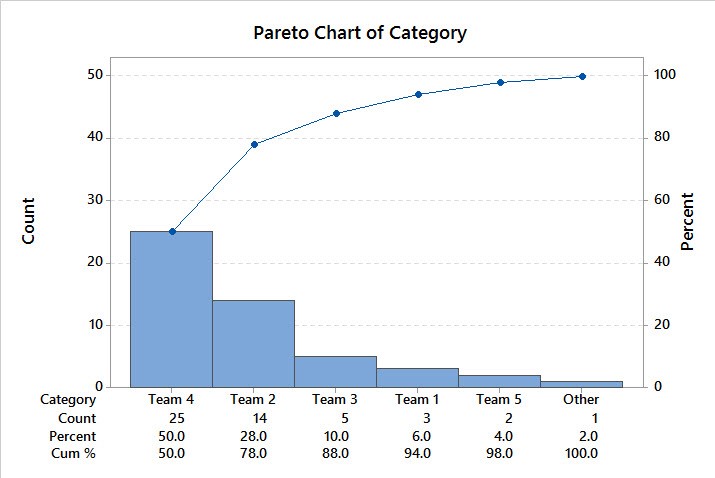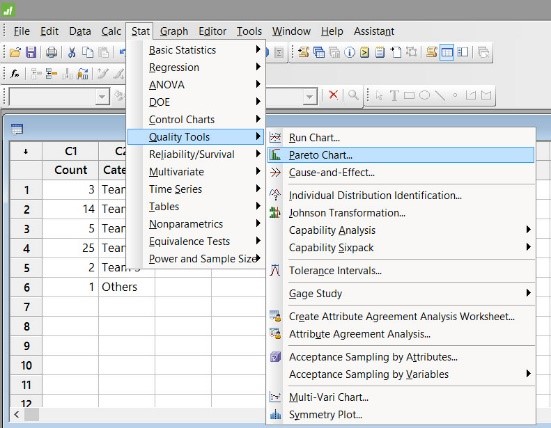
In Section 1 we have an introduction where we will look at the Agenda of course.
#Pareto chart minitab how to#
Next In section 2 we have graphical Analysis where we will look at different types of data types, different types of graphs with both theoretical concepts and how to plot those graphs using hypothetical data sets. Next in In Section 3, we will look at descriptive statistics. In this section we will look at what is mean, median, range, variance and standard deviation with formulas, once theoretical concepts are understood then we will look at how to calculate descriptive statistics in Minitab.
#Pareto chart minitab series#
#Make a pareto chart in minitab express mac how to# Welcome to Minitab’s Tutorial Series Our clip above shows how to create a Pareto Chart using Minitab Statistical Software. In the next section 4, we will look at inferential statistics. In this section, we will look at concepts like inferential statistics, what is meant by random sampling, sampling distribution, central limit theorem, and t-distribution introduction concepts. Next in section 5, we will look at hypothesis testing, in this section, we will look at concepts like confidence intervals, hypothesis testing, null hypothesis, alternate hypothesis, type I and type II errors and we will look at hypothesis tests like 1 sample t-test, 2 sample t-test, 2 variance test, paired t-test, 1 proportion test, 2 proportion test, chi-square test, etc.

Next in section 6, we will look at statistical process control charts. In this section, we will look at horizontal lines in control charts like mean, upper control limit, lower control limit, and we will look at the pre-requisites for a process to be a stable process. In Section 7 we have an introduction where we will look at the Agenda of course. Next In section 8 and section 9 we have Process Capability where we will look at process capability indices like cp, cpk, pp, ppk, sigma level and parts per million for both normal data and non-normal data theory and case studies using minitab.
#Pareto chart minitab full#
Compare Pareto Charts Created by Six Sigma Software Packages Minitab Full License: 2,499. When the process is not in control, the causes may be unstable and the vital few problems may change from week to week. Pareto Analysis is a fairly simple to perform, it an effective approach to root cause analysis. Annual License: 1,200 QI Macros - 299 USD qi macros pareto. Besides the valueable information provided by a single chart, Pareto Analysis takes the individual Pareto chart 2, 3, or four levels deeper by conducting what is called a 'second level' or 'third level' Pareto. Short periods of time may not be representative of your process as a whole.

Pareto Chart Of Standardized Effects At 0 05 Confidence Limit 2 201 Scientific Diagram. Examine the data for stratification or changes in the problem distribution over time. We need to see the data in a Graphical format, so now we produce the Pareto Chart. If your initial Pareto analysis does not yield useful results, you may want to ensure that your categories are meaningful and that your "other" category is not too large. In Minitab 17, the Pareto Chart is found at Stat > Quality Tools > Pareto. A Pareto chart is a basic quality tool that helps you identify the most frequent defects, complaints, or any other factor you can count and categorize. For example, cost may be a more useful measure for prioritization than number of occurrences, especially when the costs of various defects differ. The chart takes its name from Vilfredo Pareto, originator of the '80/20 rule,' which postulates that, roughly speaking, 20 percent of the people own 80 percent of the wealth. Or, in quality terms, 80 percent of the losses come from 20 percent. Concentrating on the problems with the highest frequency should decrease the total number of items needing rework.Concentrating on the problems with the highest cost should increase the financial benefits of the improvement.


 0 kommentar(er)
0 kommentar(er)
